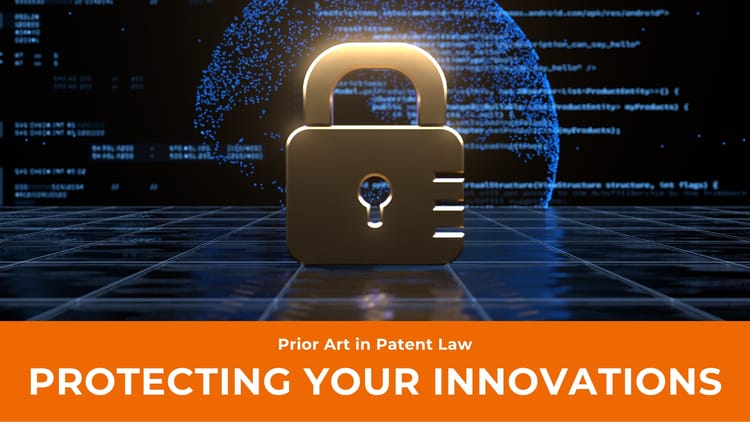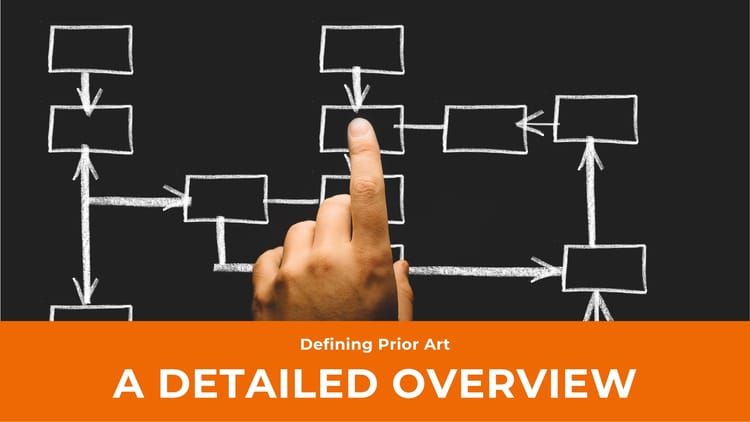Exploring the Breadth of Prior Art: More Than Just Patents
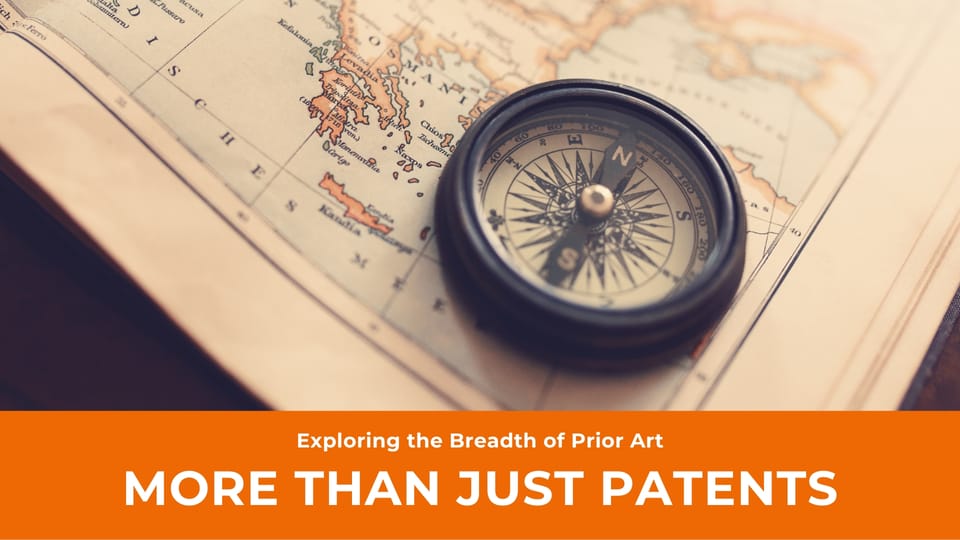
Understanding Prior Art
When delving into patent law, the term 'prior art' frequently emerges as a cornerstone concept. But what exactly is prior art? Prior art encompasses all information made available to the public before a given date that might be relevant to a patent's claims of novelty and originality. It's not just a piece of trivia in the patent world; it's the benchmark against which the novelty and non-obviousness of an invention are measured.
Understanding prior art is crucial because it helps determine whether an invention is patentable. The foundational principle here is that patents are awarded for innovations rather than for what is already known. Prior art, therefore, serves as a litmus test: if your invention has been previously disclosed in the public domain, it's not new and, consequently, not patentable. This concept is vital to prevent the re-patenting of existing inventions, ensuring that patents promote genuine innovation.
Beyond Patents
Here's a common misconception: many assume that prior art is all about existing patents. While patents form a significant portion of prior art, the scope is much broader. Prior art extends to anything publicly disclosed before the filing date of a patent application, regardless of its format or where it was released. This includes academic papers, trade journals, books, public demonstrations, and online content.
The rationale behind this broad scope is to ensure that patents are granted only for genuine advancements in technology or knowledge. By considering a wide array of sources as prior art, the patent system acknowledges the diverse ways information and innovations can be disseminated in our modern world. This understanding sets the stage for a more detailed exploration of the various forms that prior art can take, many of which go beyond the conventional boundaries of patents and published patent applications.
Non-Patent Literature as Prior Art
Moving beyond the traditional realm of patents, it's crucial to understand non-patent literature's significant role as prior art. This broad category includes academic publications, books, technical reports, and, increasingly, online publications. Each of these sources can hold the key to determining the novelty of an invention.

Academic Publications and Journals
Academic publications and journals are treasure troves of prior art. They often contain cutting-edge research, detailed studies, and comprehensive reviews of specific fields. Here’s the deal: scholarly articles are not just for academia; they are instrumental in the patent process. For instance, a scientific paper detailing a particular method or discovery could be cited as prior art to challenge the novelty of a patent claim in a related field. Patent examiners and legal professionals routinely sift through academic journals to find potentially disqualifying disclosures.
Books and Technical Reports
Similarly, published books and technical reports play a pivotal role. These sources are particularly valuable because they often provide an in-depth exploration of a subject, sometimes covering aspects that might still need to be widely known or discussed in academic papers. For example, a detailed technical manual might describe processes or technologies considered novel in a patent application but have been in the public domain for years. Recognizing the potential of these sources as prior art is crucial for a thorough patent search and evaluation process.
Online Publications
Now, let's talk about the impact of the digital age. Online publications, including websites, online journals, and digital repositories, have significantly expanded the landscape of prior art.
The ease of publishing and accessing information online means that a vast amount of potentially relevant prior art is readily available at one's fingertips. A blog post detailing a novel technique, a video tutorial on a new software feature, or an online thesis can all serve as prior art.
However, the challenge here lies in online content's sheer volume and dynamic nature. Patent searchers and legal professionals must be adept at navigating these digital resources to uncover relevant prior art effectively. The inclusion of digital content as a source of prior art reflects the patent system's adaptation to the digital era, acknowledging that innovation and public disclosure now take many forms in our interconnected world.
Public Disclosures and Demonstrations
The realm of prior art is more comprehensive than written documents and publications. Public disclosures and demonstrations, such as those at trade shows and conferences, as well as public use and sales, play a significant role. This aspect of prior art often surprises inventors, as they may need to realize that showcasing their invention publicly can have patent implications.
Trade Shows and Conferences
Trade shows and conferences are hotbeds of innovation and information exchange, but they also serve as platforms for public disclosure. Here’s the deal: when an inventor or a company demonstrates a new technology or process at these events, they effectively introduce it to the public domain. If a patent application is filed after the demonstration, the invention may no longer be considered novel. It's a common oversight – many inventors see these events as opportunities to attract investors or customers, not realizing they might compromise their ability to secure a patent.
These demonstrations don’t have to be elaborate. Even a simple presentation or a poster session can be a public disclosure. Patent applicants must carefully navigate these events, possibly considering confidentiality agreements or filing provisional patent applications before making public disclosures.
Public Use and Sales
Another critical aspect of prior art is public use and sales. If an invention has been used in public or if it has been offered for sale before a patent application is filed, it can affect the novelty of the invention. This is because the patent system is designed to reward those who promptly share their innovations with the public.
For example, selling a product or using a process in a public setting, even a trial run, can constitute prior art. Inventors and companies must be mindful of these actions. The grace period for such disclosures varies across jurisdictions, but the safest approach is to file a patent application before any public use or sale occurs.
The actions of inventors and companies in public spaces – whether at a trade show, a conference, or in the marketplace – can have significant implications for patentability. Understanding what constitutes public disclosure is crucial in strategically planning patent applications and protecting intellectual property.
Unconventional Forms of Prior Art
In today’s digital and interconnected world, prior art takes on forms far beyond traditional publications and public demonstrations. Two increasingly relevant sources are information shared on social media and blogs and internal communications like emails and documents. These unconventional forms of prior art reshape the landscape of intellectual property and patent law.
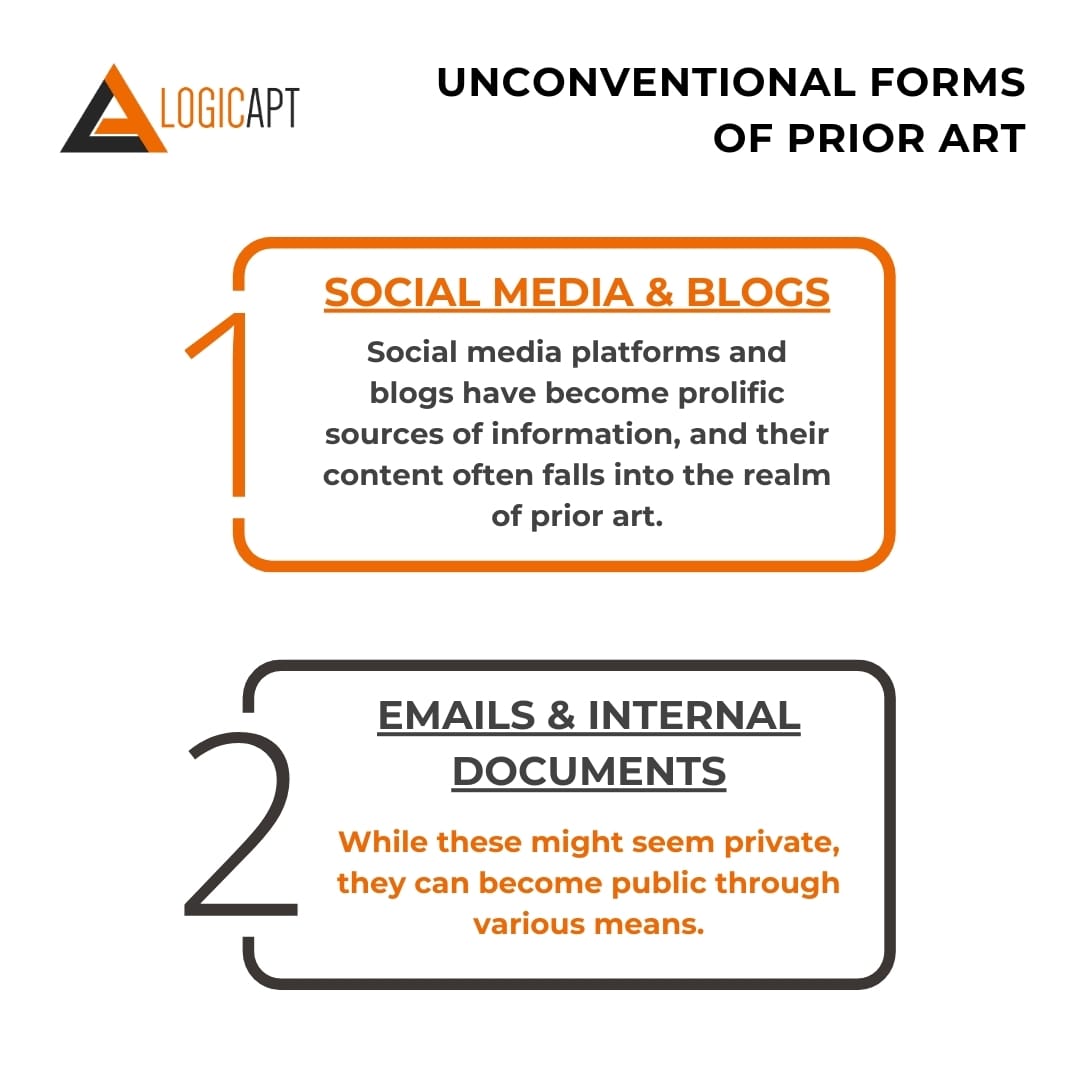
Social Media and Blogs
Social media platforms and blogs have become prolific sources of information, and their content often falls into the realm of prior art. This is crazy, but a simple tweet, a detailed blog post, or a Facebook update can invalidate a patent if it discloses an invention before the patent application date. For instance, if an inventor discusses their innovation on a blog or shares a prototype on Instagram before filing a patent, this public disclosure could be used as evidence of prior art.
The challenge with social media and blogs as prior art lies in their informal nature and vast volume. Patent examiners and legal professionals now need to consider these digital platforms in their prior art searches, which requires new strategies and tools to navigate this expansive digital landscape effectively.
Emails and Internal Documents
Another often-overlooked source of prior art is internal communication, such as emails and company documents. While these might seem private, they can become public through various means — for instance, during litigation or through a Freedom of Information Act request. An internal email discussing an invention or a company report detailing a product under development could count as prior art if it becomes public before the patent filing.
Internal communications that describe an invention in detail can jeopardize its novelty if it becomes publicly accessible. This underscores the importance of robust confidentiality policies and practices for businesses and inventors, especially when discussing potentially patentable innovations.
Global Perspectives on Prior Art
The concept of prior art is not confined within the borders of any single country. Instead, it's a global concept with varying interpretations and applications across jurisdictions. This diversity can significantly impact patent strategies and enforcement. Understanding these differences is key for inventors and businesses operating internationally.
Jurisdictional Differences
Prior art's treatment can differ markedly from one country to another, shaped by distinct legal frameworks and patent laws. For example:
- United States: Operating under a 'first-to-file' system, the U.S. considers any public disclosure before the filing date as prior art. This includes disclosures anywhere in the world, in any language.
- European Union: The European Patent Office (EPO) has a strict approach to prior art. Even disclosures made by the inventors themselves can invalidate a patent if they occur before the filing date.
- Japan and South Korea: These countries have unique nuances in their prior art treatment, often blending aspects of the U.S. and European models.
Understanding these nuances is vital for navigating the global patent landscape. What may constitute prior art in one jurisdiction might not in another, influencing where and how to file patents.
Case Studies
Let's look at some case studies to illustrate these differences:
- Smartphone Technology Patents: Consider the global patent wars in the smartphone industry. Companies often file patent infringement lawsuits in multiple countries. The same piece of prior art might be treated differently in the U.S., Europe, and Asia, leading to varying outcomes in each jurisdiction.
- Pharmaceutical Patents: A single study or trial result can be prior art in the pharmaceutical industry, where patents are crucial. How this is interpreted in different countries can significantly impact the scope and protection offered by a patent.
- Software Patents: The treatment of software-related inventions varies greatly, especially concerning prior art. Some jurisdictions are more lenient, allowing broader patentability, while others are stringent, considering a wide range of digital disclosures as prior art.
Challenges in Identifying Diverse Forms of Prior Art
In the vast and ever-expanding world of intellectual property, identifying relevant prior art presents unique challenges. From the overwhelming volume of potential sources to the dual-edged sword of technological advancements, let's delve into what makes this endeavor both demanding and dynamic.
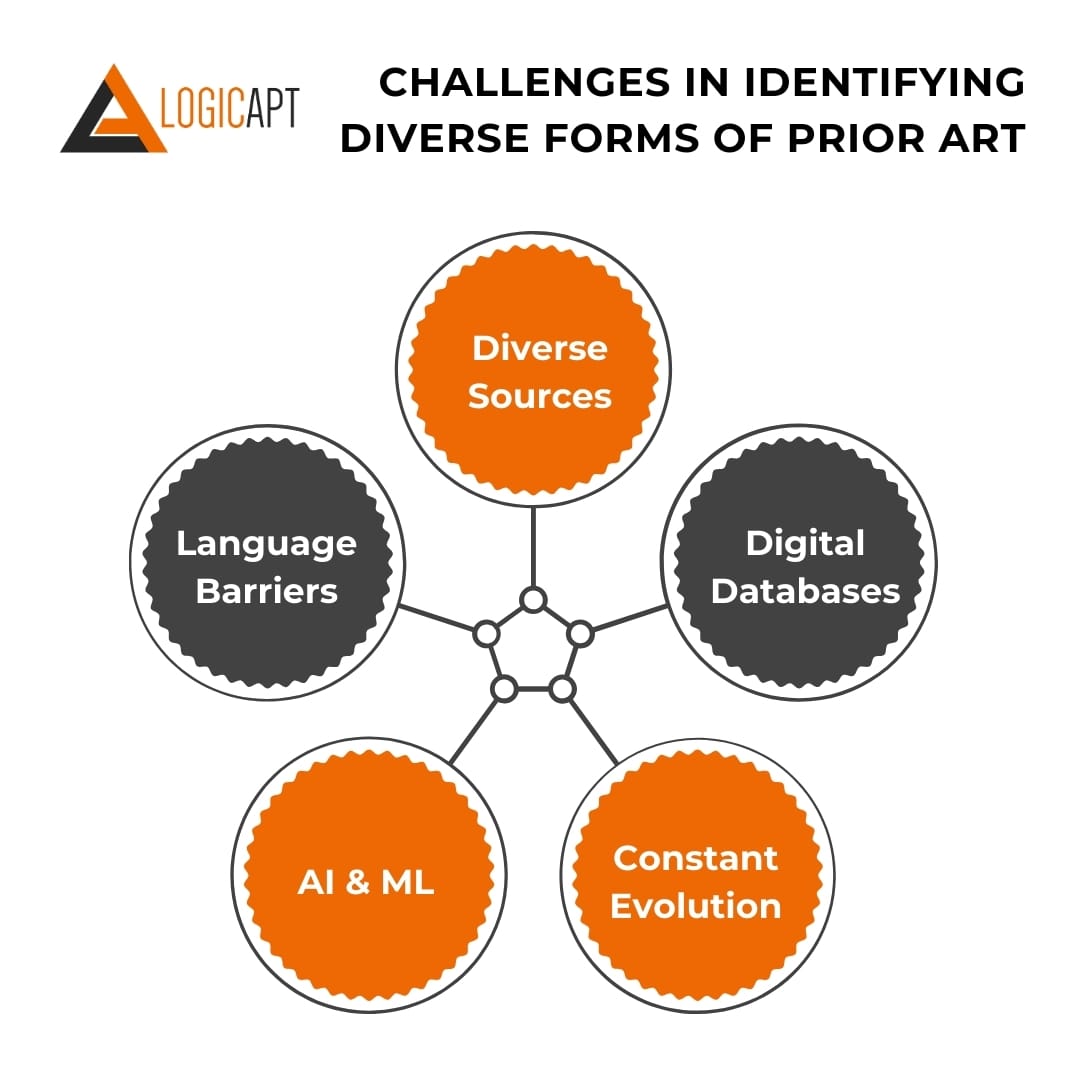
Volume and Accessibility
The first significant challenge in identifying prior art is the sheer volume of information available. In today’s digital age, the amount of potentially relevant data is staggering. It gets better/worse: while there are more resources than ever at our fingertips, sifting through this massive trove of information to find pertinent prior art is like finding a needle in a haystack.
- Diverse Sources: Prior art can come from many sources, from international patent databases and scientific journals to less formal publications like blogs and social media posts.
- Language Barriers: With global innovation, prior art can be in any language, adding a layer of complexity to the search process. Translating and understanding foreign texts is time-consuming and requires specific expertise to ensure accuracy.
Technological Advancements
On one hand, technology has revolutionized the way we search for prior art, making it more accessible and streamlined than ever before. On the other hand, it also adds to the complexity of the search.
- Digital Databases and Search Tools: Numerous databases and search tools are available to help navigate the sea of information. These include patent databases like USPTO, EPO, and WIPO, as well as academic and industry-specific repositories.
- Artificial Intelligence and Machine Learning: AI and machine learning are increasingly used to enhance the efficiency of prior art searches. These technologies can quickly process large datasets, identify patterns, and predict relevance. However, they also raise questions about accuracy and the potential for missing critical information.
- Constant Evolution: Technology and innovation constantly evolve, which means new prior art forms are continually emerging. Staying abreast of these changes and understanding how they impact the landscape of prior art is a continual challenge.
The Role of Prior Art in Innovation
In the intricate dance of innovation and intellectual property, prior art plays a more profound role than is often credited. Far from being a mere legal hurdle, it catalyzes genuine innovation and a source of competitive advantage in the business world. Let's break down how an in-depth understanding of the breadth of prior art not only fuels creativity but also drives business success.
Fostering Innovation
Prior art's first and foremost impact on innovation is its ability to inspire and inform. Here’s the deal: inventors and researchers can push the boundaries of their fields further by understanding what has already been done. Prior art is a foundation for building new ideas, ensuring that innovations are novel, not just incremental improvements in existing knowledge.
- Avoiding Duplication: A thorough knowledge of prior art helps inventors avoid reinventing the wheel, saving time, resources, and effort.
- Inspiring New Ideas: Reviewing prior art can often spark new ideas and approaches, leading to breakthrough innovations that might not have been conceived otherwise.
- Cross-Disciplinary Insights: Prior art searches can expose inventors to ideas and technologies from different disciplines, encouraging cross-pollination of ideas and fostering interdisciplinary innovations.
Competitive Advantage
A deep understanding of prior art can provide a significant competitive edge in business. Companies well-versed in the existing landscape of patents and publications are better positioned to navigate the complex waters of intellectual property rights.
- Strategic Patenting: Knowing the existing prior art landscape enables companies to file stronger, more defensible patents. It helps identify market gaps, allowing businesses to position their patents strategically.
- Risk Management: Being aware of prior art reduces the risk of patent infringement, which can be costly and damaging to a company’s reputation and operations.
- Market Positioning: Companies that effectively leverage prior art knowledge can strategically position their products and services in the market, avoiding crowded spaces and capitalizing on less explored areas.
Preparing for Effective Prior Art Searches
Embarking on a prior art search can be daunting, given the vastness and diversity of potential sources. However, this process can be streamlined and more effective with the right strategies and tools. Let's delve into how you can prepare for comprehensive prior art searches and the technological aids to make this task more manageable and efficient.
Strategies for Comprehensive Searches
A thorough prior art search requires a methodical approach and keen attention to detail. Here are some strategies to consider:
- Define the Scope Clearly: Start by defining your invention's scope. Understanding what you need to search for is the first step in a targeted prior art search.
- Utilize Diverse Sources: Don’t limit your search to patents and applications. Expand it to include non-patent literature like academic journals, industry publications, online databases, and even less formal sources like blogs and social media.
- Classify Your Search: Break down your search into categories based on different aspects of your invention – technology, application, design, etc. This helps in conducting a more organized and thorough search.
- Stay Current: The world of technology and innovation is constantly evolving. Regularly update your search to include the latest publications and patents.
Leveraging Technology
Technology can be a powerful ally in prior art searches. Here are some tools and platforms that can enhance the efficiency and effectiveness of your searches:
- Patent Databases: Utilize databases like the USPTO, EPO’s Espacenet, and WIPO’s PATENTSCOPE for accessing a wide range of patents and patent applications.
- Academic and Industry Databases: Platforms like Google Scholar, IEEE Xplore, and JSTOR provide access to academic papers and technical reports, which can be crucial sources of prior art.
- AI-Powered Search Tools: Consider using advanced search tools that employ AI and machine learning algorithms. These tools can process vast amounts of data quickly, identify patterns, and even suggest relevant prior art based on the context of your search.
- Professional Search Services: Sometimes, the complexity of the task warrants the use of professional prior art search services. Often staffed with experts in various fields, these services can provide comprehensive search reports and analyses.
Conclusion
As we explore the expansive world of prior art, it’s clear that this concept stretches far beyond the confines of patents and patent applications. Prior art is a multifaceted entity, encompassing many sources and forms, each playing a critical role in the intellectual property and innovation landscape.
Summary of Key Insights
- Broad Definition: We established that prior art is not limited to existing patents but includes academic publications, technical reports, online content, public disclosures, and social media and internal communications.
- Global Perspectives: The treatment of prior art varies significantly across different jurisdictions, underscoring the importance of a global perspective in patent strategies.
- Role in Innovation: Far from being a mere legal hurdle, prior art is instrumental in fostering genuine innovation and providing a competitive edge in the business realm.
- Challenges in Identification: The process of identifying relevant prior art is fraught with challenges due to the volume of information and the evolving nature of technology.
- Effective Search Strategies: To navigate these challenges, we discussed strategies for comprehensive searches and the role of technology in facilitating these efforts.

External Links for Further Exploration
- Patent Databases
- USPTO Patent Database: United States Patent and Trademark Office
- EPO’s Espacenet: European Patent Office’s Espacenet
- WIPO’s PATENTSCOPE: World Intellectual Property Organization's PATENTSCOPE
- Academic and Industry Journals
- Google Scholar: Google Scholar for academic papers and articles.
- IEEE Xplore: IEEE Xplore Digital Library for technical and scientific research.
- JSTOR: JSTOR for access to thousands of academic journals, books, and primary sources.
- Legal Resources and Case Studies
- Cornell Law School's Legal Information Institute: LII / Legal Information Institute for comprehensive legal information and case law.
- Harvard Law School Case Studies: Harvard Law School | The Case Studies for a collection of legal case studies.
- AI and Machine Learning in Prior Art Search
- IEEE Spectrum – AI in Patent Searches: An article on how AI transforms patent searches, available at IEEE Spectrum.
- Global Intellectual Property Law
- World Trade Organization - TRIPS: WTO | Intellectual property (TRIPS) - gateway for information on the Agreement on Trade-Related Aspects of Intellectual Property Rights.
- WIPO's Guide to International Patent Law: WIPO - International Patent Law.

